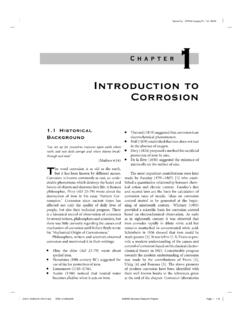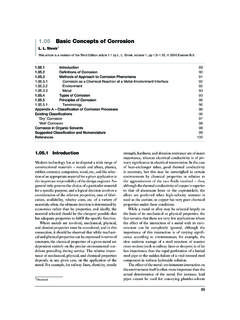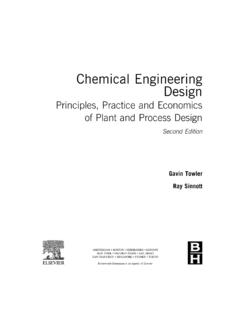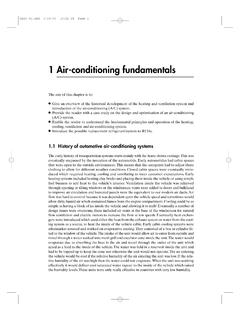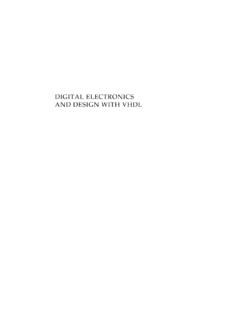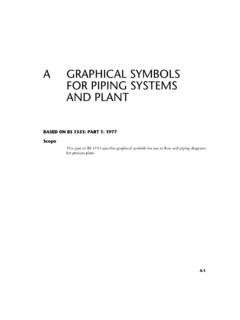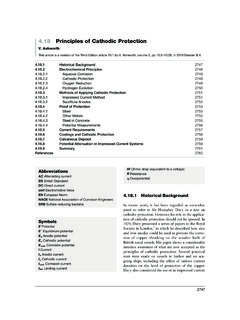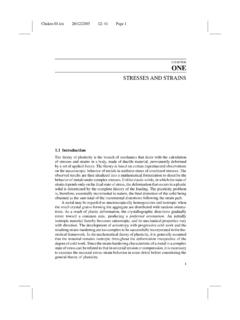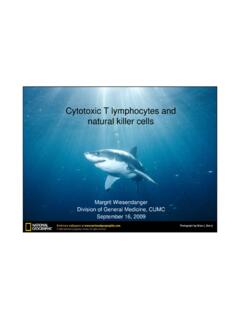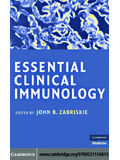Transcription of IMMUNOLOGY - Elsevier.com
1 873 IMMUNOLOGYGLOSSARY88 THE IMMUNE RESPONSE SYSTEM92 Innate and adaptive immunity92 Cells and molecules involved in theimmune response93 Antigen-recognition lymphoid cells (B and T lymphocytes) 93 Granulocytes 98 Macrophages 98 Dendritic cells 98 Natural killer cells 99 Cytokines 99 Accessory molecules 103 Other molecules 104 Apoptosis 105 IMMUNOGLOBULINS105 Properties, functions and reactions105 Structure of immunoglobulin molecule108 Clinical considerations109 Paraprotein 109 Macroglobulins 110 Cryoglobulins 110 Cold agglutinins 110 Monoclonal antibodies 110 COMPLEMENT111 The complement system111 Complement pathways111 Complement deficiencies112 HYPERSENSITIVITY112 Classification112 IMMUNODEFICIENCY115 Primary immunodeficiency115B-cell disorders 115T-cell disorders 116 Combined B- and T-cell disorders 116 Neutrophil disorders 117 Secondary immunodeficiency118 Hypogammaglobulinaemia 118T-cell deficiency 118 Hypergammaglobulinaemia 119 AUTOIMMUNE DISEASE120 Explanatory theories for breakdown inself tolerance121 Autoantibodies121 Antinuclear antibodies 122 BLOOD GROUP IMMUNOLOGY123 ABO group123 Rhesus (CDE)
2 Group124 Rhesus incompatibility 124 Minor blood group system 124 transplantation IMMUNOLOGY124 Terminology124 Graft rejection and survival125 Stem cell transplantation126 Graft versus host disease (GVHD)126 Xenotransplantation127 TUMOUR IMMUNOLOGY127 Tumour-associated antigen127 Tumours of the immune system128 IMMUNOLOGICAL ASSAYS1291. Agglutination assays129 Coombs antiglobulin test 1292. Complement fixation tests1293. Immunofluorescence tests130 Flow cytometry 1304. Immunoenzyme assays1305. Radioimmunoassay1316. 3/1/05 10:29 AM Page 87 GLOSSARYA daptive The transfer of immune cells for therapeutic , antibody-A cytotoxic reaction in which the Fc receptor-bearing dependent cellularkiller cells recognize target cells via specific Cell surface molecules involved in cell cell interaction ormoleculesthe binding of cells to extracellular matrix, where theprincipal function is adhesion rather than cell activation, integrins and foreign material introduced with an antigen toenhance its immunogenecity, killed bacteria,(mycobacteria), emulsions (Freund s adjuvant) orprecipitates (alums).
3 AlloantibodyAntibody raised in one individual and directed againstan antigen (primarily on cells) of another individual ofthe same page protein of an allele which may be detectable as anantigen by another member of the same proteins are an example of antigenicallydissimilar pathwayThe activation pathways of the complement systeminvolving C3 and factors B, D, P, H and I, which interactin the vicinity of an activator surface to form analternative pathway C3 peptides (C3a and C5a) which cause mastcell degranulation and smooth muscle residuesCertain amino acid residues of antigenic peptides arerequired for interaction in the binding pocket of peptidesPeptide fragments of proteins which bind to MHCmolecules and induce T-cell (antigen-A variety of cell types which carry antigen in a form that presenting cells)can stimulate cell death: a mode of cell death whichoccurs under physiological conditions and is controlledby the dying cell itself ( cell suicide ).
4 AutologousOriginating from the same individual. 2-microglobulinA polypeptide which constitutes part of some membraneproteins including the class I MHC molecule expressed transiently on activated B cellswhich have been rescued from markers Used as a prefix (and number). Cell surface molecules (cluster of of lymphocytes and platelets that are distinguishable differentiation)with monoclonal antibodies, and may be used todistinguish different cell 3/1/05 10:29 AM Page 88 Cell adhesion A group of proteins of the immunoglobulin supergene molecules (CAMs)family involved in intercellular adhesion, including ICAM-1, ICAM-2, ICAM-3, VCAM-1, MAd CAM-1 I/II restrictionThe observation that immunologically active cells willonly operate effectively when they share MHChaplotypes of either the class I or class II switchingThe process by which B cells can express a new heavychain isotype without altering the specificity of theantibody produced.
5 This occurs by gene selectionThe fundamental basis of lymphocyte activation inwhich antigen selectively causes activation, division anddifferentiation only in those cells which expressreceptors with which it can group of large polymeric proteins includingconglutinin and mannose-binding lectin (MBL) that canopsonize microbial group of cytokines which control the differentiation of factors (CSFs)haemopoetic stem regionsThe relatively invariant parts of the immunoglobulinheavy and light chains, and the , , and chains ofthe T-cell signals required for the activation of lymphocytes inaddition to the antigen-specific signal delivered via theirantigen receptors. CD28 is an important costimulatingmolecule for T cells and CD40 for B group of small antibacterial proteins produced cellsDerived from either the lymphoid or mononuclearphagocyte lineages.
6 A set of cells present in tissues,which capture antigen and migrate to lymph nodes andspleen, where they are particularly active in presentingthe processed antigen to T or loops on heavy and light chains formed byintrachain disulphide bonds. Each immunoglobulindomain consists of about 110 amino of an antigen that binds to an antibody-combiningsite or a specific T-cell surface receptor, and determinesspecificity. Usually about 9 20 amino acids in ligandThe ligand that binds to the cell surface molecule Fas(CD95) which is normally found on the surface oflymphocytes. When Fas ligand binds to its receptor, celldeath (apoptosis) is restrictionDescribes the phenomenon where lymphocytes andantigen-presenting cells interact more effectively whenthey share particular MHC of lymphoid tissue associated with the lymphoid tissuegastrointestinal tract.
7 (GALT) 3/1/05 10:29 AM Page 89 HaplotypeA set of genetic determinants coded by closely linkedgenes on a single substance of low molecular weight which is not itselfimmunogenic, but which can bind to an antibodymolecule and produce a new antigenic (THcells)A functional subclass of T cells which can help generate cytotoxic T cells and cooperate with B cells in the production of antibody responses. Helper cellsrecognize antigen in association with class II from a different individual or different antigenAntigen which occurs in tissues of many differentspecies and is therefore highly crossreactive, Bunnell antigen which reacts with both sheep andbeef page antigenic determinant on the antigen-bindingregion of an immunoglobulin Amino acid sequences within the variable regions of regionsheavy and light immunoglobulin chains and of the T-cellreceptor which show the most variability and contributemost to the antigen-binding of the same class that is detectable in subclassthe constant heavy chain region, and differs inelectrophoretic mobility and antigenic determinant, andfunction, IgG1, IgG2, IgG3 and which have domains homologous to those supergeneseen in immunoglobulins.
8 Including MHC class I and II family (lgSF)molecules, the T-cell receptor, CD2, CD3, CD4, CD8 ICAMs, VCAM and some of the Fc surface molecules found on a variety of leucocytes adhesion moleculesand non-haematogenous cells which interact with leucocyte functional antigen (LFA-1); ICAM-1 (CD54),ICAM-2 (CD102) and ICAM-3 (CD50).IntegrinsOne of the families of adhesion molecules, some ofwhich interact with cell adhesion molecules, and otherswith components of the extracellular from the same individual or member of thesame inbred class or subclass of an immunoglobulin common toall members of that species. Each isotype is encodedby a separate immunoglobulin constant region genesequence that is carried by all members of a (K) cellsType of cytotoxic lymphocyte that is able to mediateantibody-dependent cellular cytotoxicity (ADCC).
9 Langerhans cellsAntigen-presenting cells of the skin which emigrate tolocal lymph nodes to become dendritic cells; they arevery active in presenting antigen to T 3/1/05 10:29 AM Page 90 Lectin pathwayA pathway of complement activation, initiated bymannose-binding lectin (MBL) which intersects theclassical A group of three molecules (LFA-1 (CD11a/CD18), functional antigens LFA-2 (CD2) and LFA-3 (CD58)), which mediate (LFAs)intercellular adhesion between leucocytes and othercells in an antigen non-specific The association of two linked alleles more frequently disequilibriumthan would be expected by cellsLong-lived lymphocytes which have already beenprimed with antigen but have not yet undergoneterminal differentiation into effector cells. They reactmore readily than na ve lymphocytes when restimulatedwith the same lymphocyte Proliferative response when lymphocytes from two reaction (MLR)genetically different ( allogeneic) persons are mixedin cell culture.
10 A vital test in matching donor andrecipient prior to bone marrow tissue associated with the bronchial tree, lymphoid tissue gastrointestinal tract and other mucosa.(MALT)Natural killerType of cytotoxic lymphocyte that has the intrinsic (NK) cellability to recognize and destroy virally infected cells andsome tumour cells. Specializes in killing cells thatexpress little or no MHC transcription factor which is widely used by differentleucocyte populations to signal granule-associated molecule of cytotoxic cells,homologous to complement C9. It can form pores onthe membrane of a target oxygen/Bactericidal metabolites produced by phagocytic cells, nitrogen including hydrogen peroxide, hypophalites and nitric intermediates acid.(ROIs/RNIs)SelectinsThree adhesion molecules, P-selectin (CD62P), E-selectin (CD62E), and L-selectin (CD62L) involved inslowing leucocytes during their transit through (often bacterial, staphylococcalenterotoxins) which bind to the MHC outside thepeptide-binding groove and stimulate all or most of theT cells bearing particular T-cell receptor V must normally be processed in order to triggerthe T-cell receptor.
